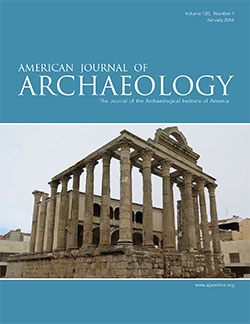AJA Open Access
BY-NCJanuary 2016 (120.1)
Book Review
The Economics of the Roman Stone Trade
By Ben Russell
Reviewed by Lynne Lancaster
In this book, Russell has brought together an impressive array of evidence, both old and new, in an effort to add the study of stone to the conversations about the Roman economy. It represents the fruits of his Oxford dissertation, which started as part of the Oxford Roman Economy Project (www.romaneconomy.ox.ac.uk). Russell is particularly concerned with process: how was the extraction, transportation, and dissemination organized, and who were the ones determining that organization? The book is essentially an in-depth survey of what we know about the stone trade. However, it is a survey with a message. He starts by noting that he is challenging the model of the Roman marble trade laid out by J.B. Ward-Perkins, which Russell summarizes thus: “as demand for decorative stone swelled, notably in the first and second centuries AD, stone production was reorganized along quasi-industrial lines: production became centered on the quarries, with objects being carved in standardized forms and dimensions to stock” (3). Inherent in Ward-Perkins’ model is the assumption of centralized imperial control over the quarries producing the most desirable stones. Russell, on the contrary, emphasizes the great diversity of practices throughout the empire and with it a more seminal role for the consumer in determining the patterns of distribution. His approach is part of a broader shift away from seeing the Roman empire as driven from the imperial center and toward allowing for greater agency for individuals, particularly those outside Rome.
The book is a goldmine of up-to-date information spread over nine chapters. Chapters 1–5 deal with topics such as the market for stone, quarrying, transport, and distribution patterns. Each chapter is divided into subtopics, which, along with the excellent index, allows the reader to dip easily into areas of particular interest. The discussions draw on a variety of types of evidence: literary sources, papyri, ostraka, quarry inscriptions, tool working, and finds in quarries and shipwrecks. They offer a broad but detailed overview of the trade in stone, ranging from local municipal limestone quarries to imperial marble quarries. Given the breadth of material, I focus the remainder of this brief review on the material in chapters 6–8, each of which deals with a specific class of item: architectural elements, sarcophagi, and statuary, respectively. These chapters are where the underlying theme is most evident, and they are the ones most likely to generate discussion.
Architectural elements formed the centerpiece of Ward-Perkins’ proposal that there was a move to production-to-stock during the second century. Having noted that column shafts tended to come in lengths of multiples of 5 Roman feet, he contended that this phenomenon was part of the larger imperial move to rationalize production. To test this idea, Russell collected 117 shaft lengths, ranging from 10 to 55 Roman feet from 11 different quarries. The resulting graph (fig. 6.7) reveals that the modular system is roughly borne out for columns longer than 30 Roman feet (ca. 9 m) but not for the smaller ones. He suggests that the standardization of the large column shafts does not represent production-to-stock so much as a convenient method for working out proportions of column design, as proposed by Mark Wilson Jones. In this interpretation, standardization would not be driven by the production methods in the quarry but rather by the architects designing large structures who requested certain standard-sized columns to make the job easier. The massive increase in the use of colored stone columns was one aspect of what Ward-Perkins dubbed the “marble style,” which was often characterized by facades decorated with a multitude of columns, especially in nymphaea and the scaenae frons of theaters. Given that the columns in these facades rarely reached the 30 Roman feet mark, further analysis of column sizes in these structures could yield useful insights into the effects, if any, of standardization on design. One area where Russell does see evidence for production-to-stock (as opposed to standardization) is for blocks intended to be sawn into veneer panels.
Russell also takes issue with Ward-Perkins’ belief that decisions in the quarry drove the distribution of sarcophagi through branch workshops strategically established in certain cities. In this scenario, a quarry workshop could rough out a sarcophagus and then send it to the branch workshop, where it would be finished for local consumers, who would buy whatever was available “off the shelf.” Russell argues for a model in which independent workshops would place specific orders from the quarry based on their clients’ requests. He counters Ward-Perkins’ idea of particular quarries producing certain shapes and designs of sarcophagi by showing that sarcophagus types (e.g., lenos and garland sarcophagi) were produced in a variety of marble types. Moreover, different levels of finish found on sarcophagi in the same quarry indicate variability in the production modes, even within a single quarry (263–69). Ultimately, Russell sees the distribution patterns of various sarcophagus types as determined by local demand rather than as the result of targeted marketing by the quarry. However, he acknowledges that some of the hollowed-out blanks found on shipwrecks could have been aimed at stockpiling. The chapter on statuary takes a broadly similar position in advocating for commissions over production-to-stock, but the evidence here is more disparate.
As Russell states at the beginning, his approach goes “away from modelling homogeneity to interpreting heterogeneity” (6). The word choice is apt. Many of the arguments are based on interpretations of the evidence that are different from those traditionally held, but the evidence is not always sufficient to confirm one interpretation over another; thus, some of his arguments may not find universal acceptance. Nevertheless, Russell has changed the nature of the conversation. By peering through the opposite side of the looking glass, he has shifted the focus from the emperor and his quarries to the individual consumers.
Lynne C. Lancaster
Department of Classics and World Religions
Ohio University
lancaste@ohio.edu
